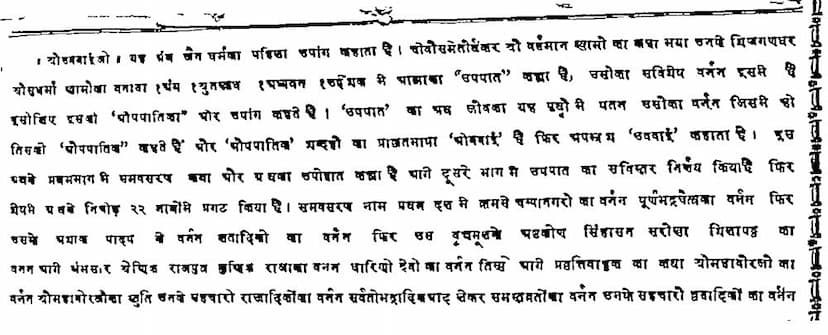Agam 12 Upang 01 Aupapatik Sutra Shwetambar
Added to library: September 1, 2025

Summary
Based on the provided text fragments from the Agam 12 Upang 01 Aupapatik Sutra (Shwetambar tradition), here's a comprehensive summary:
Overall Theme and Purpose:
The Aupapatik Sutra, the first Upanga in Jain Agamas, details the "upasarga" or the process of birth and existence in the Jain cosmology, specifically focusing on the destiny and life experiences of beings in different realms. It aims to elucidate the workings of karma and its impact on the soul's journey through the cycle of birth and death (samsara). The text also emphasizes the importance of righteous conduct, adherence to Jain principles, and the pursuit of liberation (moksha) through spiritual practices like penance and ethical living.
Key Concepts and Content (as gleaned from the fragmented text):
The text extensively describes various aspects of existence, with a particular focus on:
-
Types of Beings and Their Origins (Upapada): The sutra delves into the concept of "upasarga" (birth or descent) and "upapada" (spontaneous birth), explaining how beings are born in different realms. It categorizes beings based on their birth, such as:
- Devas (Gods): Descriptions of various celestial beings, their lifespans, enjoyments, and the heavens they inhabit.
- Narakis (Hell-beings): Details about beings in hellish realms, their suffering, and the conditions of those realms.
- Tiryan-yoni (Sub-human realm): This includes animals, birds, insects, and other creatures, with descriptions of their diverse forms and karmic consequences.
- Manushya-yoni (Human realm): The human realm is given significant attention, with detailed descriptions of cities, palaces, individuals, their virtues, vices, and the consequences of their actions.
-
The Samavasarana: A significant portion of the text appears dedicated to the Samavasarana, the divine assembly convened by an omniscient Tirthankara. It describes:
- The City: Detailed descriptions of cities like Champanagari, their structure, beauty, and inhabitants.
- The Assembly: The composition of the Samavasarana, including the presence of gods, celestial beings, various types of humans, and their respective positions and activities.
- The Tirthankara's Sermon: The description of the Tirthankara (Lord Mahavira is frequently mentioned) delivering the sermon, the auspicious atmosphere, and the profound impact of his teachings.
-
Karmic Law: While not explicitly stated as a separate chapter, the underlying principle of karma is evident throughout. The descriptions of beings' births, experiences, and suffering strongly imply the operation of karma – the law of cause and effect for actions. Virtuous actions lead to pleasant births and experiences, while unwholesome actions result in suffering and unfavorable circumstances.
-
Description of Nature and Environment: The text provides rich and detailed descriptions of the natural world, including:
- Cities and Palaces: Elaborate accounts of the grandeur, architecture, and beauty of cities and royal residences, often highlighting their opulence and divine qualities.
- Gardens and Groves: Vivid descriptions of lush gardens, celestial trees (like the Ashoka tree), flowers, fragrances, and the pleasant environments associated with them.
- Celestial Beings and Vehicles: Mentions of various gods and their vehicles, emphasizing the celestial splendor.
-
Moral and Ethical Teachings: Interspersed with the narrative and descriptive passages are moral exhortations and explanations of righteous conduct. The text likely emphasizes the importance of:
- Ahimsa (Non-violence): A foundational principle of Jainism.
- Contentment and Renunciation: The need to detach from worldly pleasures and possessions.
- Austerities (Tapas): The practice of self-discipline and penance for karmic purification.
- Righteous Conduct: Following the path of dharma and ethical living.
-
Lord Mahavira's Life and Teachings: The text centers around Lord Mahavira, the 24th Tirthankara, recounting aspects of his life, his sermons, and his interactions with disciples and royalty. The descriptions of the Samavasarana and his teachings are central.
-
Detailed Descriptions: The language used is highly descriptive, employing a vast vocabulary to paint vivid pictures of the places, people, and celestial phenomena. This detail likely serves to impress upon the reader the scale and grandeur of the Jain universe and the consequences of actions within it.
Structure (Inferred from Fragmented Text):
The text appears to be structured in sections or chapters, possibly dealing with different aspects of birth and existence:
- An introductory section (Upohat) describing the Samavasarana.
- A detailed section on "Upapada" (types of birth).
- Concluding sections summarizing key principles or providing further elaborations.
Publisher and Author:
The text is attributed to Rai Dhanpatsinh Bahadur, who also published it. The catalog link is provided for further exploration.
In essence, the Aupapatik Sutra, as suggested by these fragments, is a foundational Jain text that uses detailed cosmological and narrative descriptions, particularly surrounding Lord Mahavira's Samavasarana, to illustrate the principles of karma, the cycle of rebirth, and the path to spiritual liberation. The sheer volume of descriptive language points to its intent to create a rich and immersive understanding of the Jain worldview for its followers.